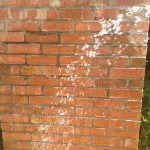Does Brick Waterproofing Make Sense?

In older homes, solid brick walls absorb and release water as necessary through tiny passageways that allow the brick and mortar to breathe. In veneer brick homes, there is only one layer of brick. If that is jeopardized, water leaks in the home can become a problem.
It is important to note the difference between water repellants and sealants. Water repellants soak into the brick and coat the passageways leaving them open. Sealants however, form a barrier, closing these passages. When sealants are used in four-season climates such as Chicago, spalling or flaking can occur. It is best to avoid the use of sealants in our area.
Brick waterproofing is beneficial when a portion of brickwork has been repaired alongside older, existing masonry. Having old and new brickwork may cause a negative reaction if not waterproofed. It can also be beneficial when brickwork is below grade, has hairline cracks or is soft and porous with soft mortar joints. Repairs to cracks or deteriorating joints should be made before applying the water repellant.
Visually clear, water repellant will not discolor or change the appearance of your brick. It does need to be reapplied every four to ten years depending on the age of the structure. Does brick waterproofing make sense for your Chicago area home or building? Give Shamrock Tuckpointing a call to find out.


